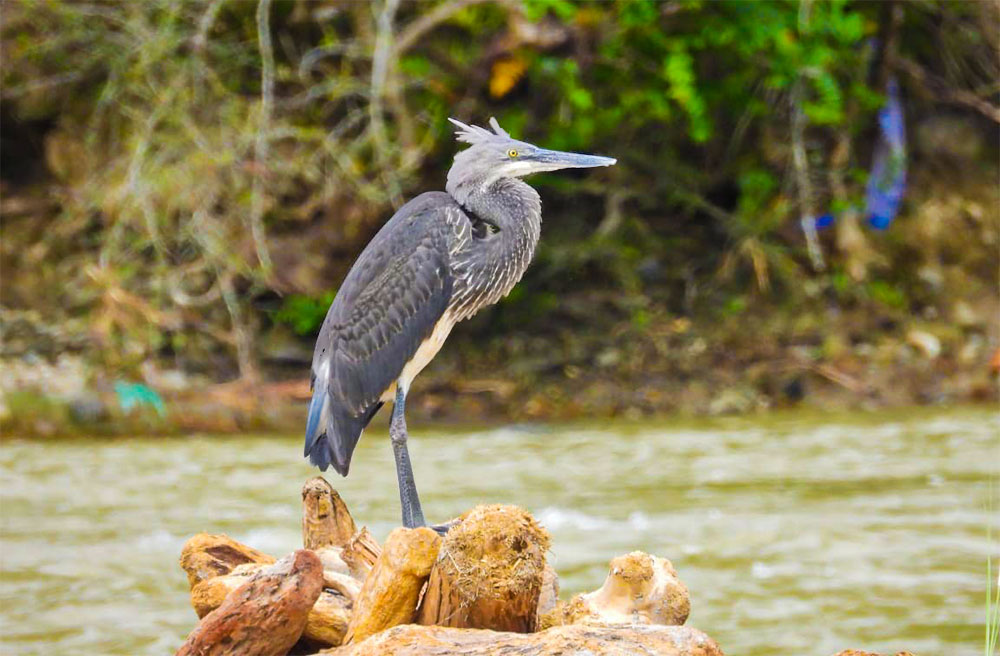Yangyel Lhaden
Bhutan recorded 27 white-bellied herons (WBH) this year across 14 of its habitats, four more compared to last year.
This includes three juveniles that were recorded during the Annual Nationwide Population Count which was conducted for five days from March 1, 2023, according to a report on WBH from the annual population survey by Royal Society for Protection of Nature (RSPN).
WBH is a critically endangered species of heron with less than 60 individuals worldwide. It is found only in the Himalayan region in Bhutan, North-East India, and Myanmar. The presence of WBH indicates a healthy ecosystem and it is a top predator in the aquatic ecosystem.
The highest number of WBH was found in Punatsangchhu (14), followed by Mangdechhu and Wangchhu (4), during the survey. There are three WBH in RSPN’s WBH conservation centre.
This year two more WBH were observed in Punatsangchhu and three more in Wangchhu basin and the bird count in Mangdechhu dropped by four.
“The number of WBH over the years, since our survey, has been a positive trend,” Executive Director of RSPN, Kinley Tenzin (PhD) said.
“It is important to conserve WBH because it is part of an ecosystem and every species has a role in the ecosystem and only when one goes extinct, we realise the role of the species,” RSPN’s Chief of Species Conservation Division, Indra Acharja said.
According to Kinley Tenzin, in the 1980s, people resorted to poisoning wild dogs due to the negative impact they had on people’s livelihoods, leading to their extinction. As a consequence, the prey of wild dogs, such as wild boars and deer, experienced a population increase, which in turn escalated human-wildlife conflicts. Consequently, wild dogs were reintroduced in the 1990s.
Indra Acharja said that now wild dogs were highly protected and there is a wild dog conservation Act.
Kinley Tenzin said that according to the prediction model RSPN did with Japanese expert, it is predicted that WBH would go extinct by 2050 if it is left in the wild without human intervention.
In the wild, threats to WBH landscape include threats from fishing and related activities, local activities, natural resources extraction, infrastructure development, habitat degradation, hydropower development, ecotourism and recreational activities, and timber and firewood, according to the survey.
During the survey, zone one, Phochhu recorded the highest frequency of threat from local activities followed by Zone 15, Jigmechhu and Wangchhu. Fewer threats were recorded in Zone Four Lhamoidzingkha, Rangtae, and Gumti, lower Punatsangchhu, and zone seven, Goling and Tshaidang area. There was no threat recorded from zone five, Phibsoo Wildlife Sanctuary.
“The survival rate of WBH juveniles is only about 10 percent in the wild,” Indra Acharja said. “ Every year we record about four to eight chicks but during population survey, their number never increases.”
“Bhutan is the only country which has recorded breeding pairs of WBH,” Indra Acharja said. “Currently, we have three breeding pairs.”
RSPN is focusing more on captive breeding, Kinley Tenzin said. “We are looking to breed eggs from different families for genetic diversity in our centre.”
Kinley Tenzin said that for species with low populations, captive breeding is the only viable option due to limited success in breeding them in the wild. Efforts to improve the natural habitat through community involvement have had low success rates, leading to a focus on captive breeding.
“After breeding and nurturing WBH in our centre, we will release them into the wild,” Kinley Tenzin said. “They have a higher survival rate in the wild when they are adults.”
The birds are sensitive to human disturbances and move to places with less disturbance.
Kinley Tenzin said that in over 20 years of looking after WBH, they have spotted WBH in places they were normally not found such as Jigmechhu, Chamkharchhu, Kholongchhu. It is a good sign that adults can disperse and adapt.”


